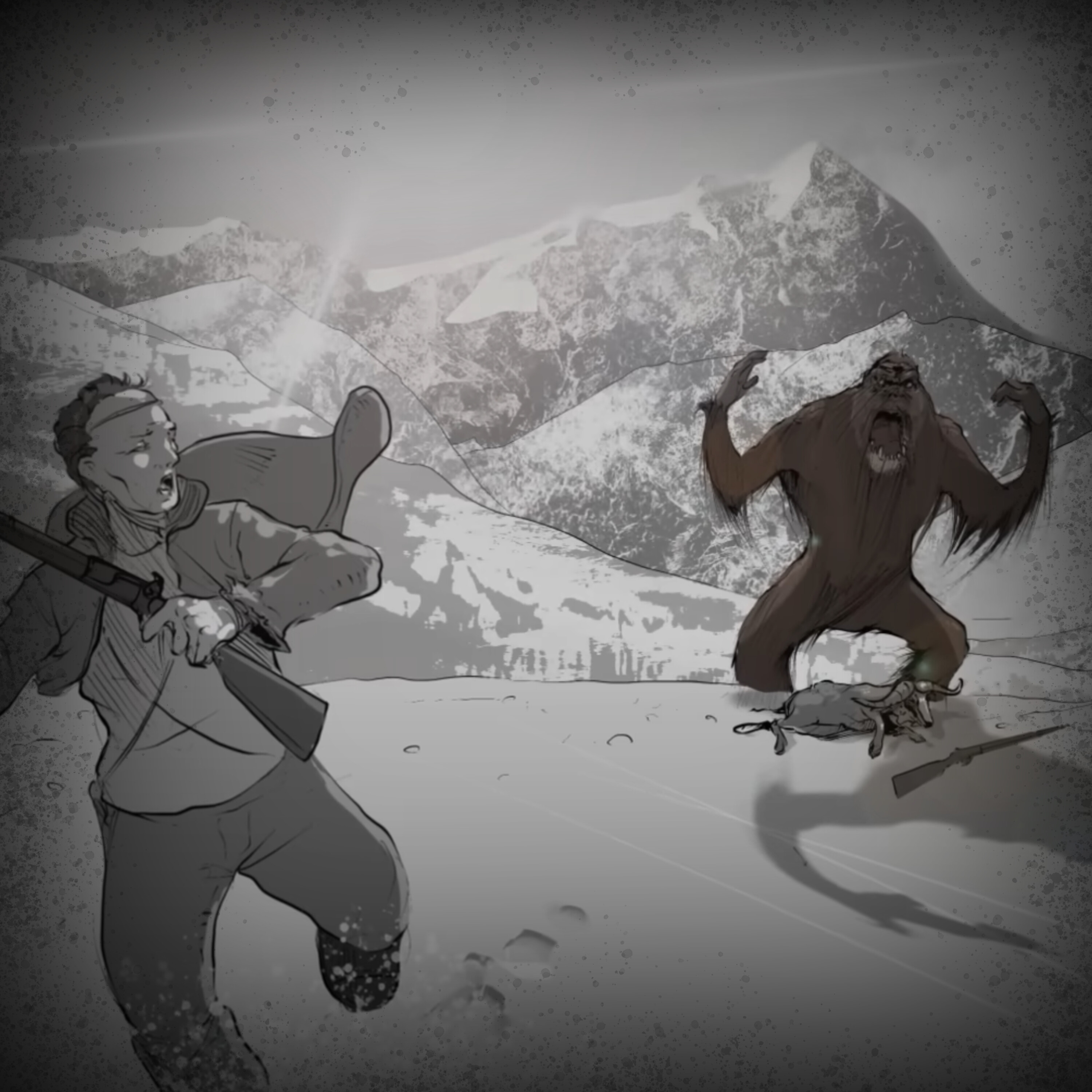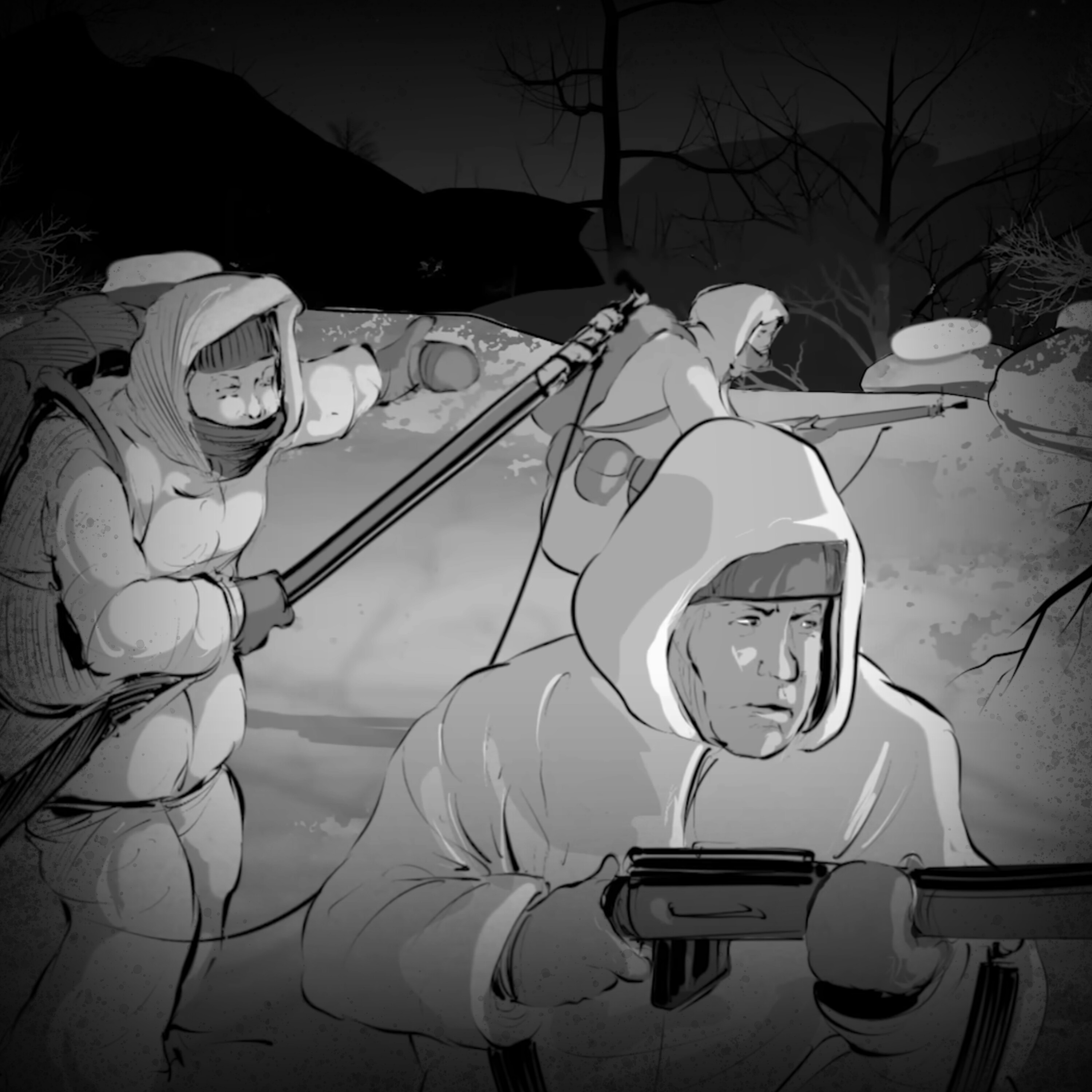The Indian Army and the Yeti, Pt. 1
An Indian Army expedition discovers massive footprints in the snow.
See Privacy Policy at https://art19.com/privacy and California Privacy Notice at https://art19.com/privacy#do-not-sell-my-info.
Press play and read along
Transcript
Speaker 1 Wondery Plus subscribers can listen to new episodes of Wartime Stories early and ad-free right now. Join Wondery Plus in the Wondery app or on Apple Podcasts.
Speaker 3 Big moments or small moments? They all deserve great style. At Maurice's, we're here to help you show up feeling your best, no matter what's on your calendar.
Speaker 3 Whether it's a date night, a special event, or just another Tuesday. Our over 800 stylists are here to help.
Speaker 3 From tried and true denim to head-turning looks, we've got style that fits your life and your budget. Visit your local Maurice's to find fashion fit for you with a little help from us.
Speaker 4 I've never felt like this before. It's like you just get me.
Speaker 4 I feel like my true self with you. Does that sound crazy? And it doesn't hurt that you're gorgeous.
Speaker 4 Okay, that's it. I'm taking you home with me.
Speaker 4 I mean, you can't find shoes this good just anywhere. Find a shoe for every you from brands brands you love like Birkenstock, Nike, Adidas, and more at your DSW store or dsw.com.
Speaker 2 In 2019, a team of 18 soldiers assigned to the Indian Army's Mountaineering Expedition Team were conducting a commemorative two-month-long trek to Summit Makalu, which is the fifth highest mountain peak in the world.
Speaker 2 Having departed the city of Delhi a month earlier while they were resting at a waypoint called Langmale Karka to conduct high-altitude acclimatization before continuing on to the Makalu base camp, they stumbled on something quite unexpected near their campsite.
Speaker 2 Something that would make their blood run colder than the freezing weather had managed to.
Speaker 2 It was footprints,
Speaker 2 massive footprints in the snow.
Speaker 2 The question remains unanswered, however.
Speaker 2 Are these footprints newly discovered evidence of a creature that has eluded mankind for centuries?
Speaker 2 This is the story of the Indian Army and the Yeti.
Speaker 2 I'm Luke Lamana,
Speaker 2 and this is Wartime Stories.
Speaker 2 The Indian Army Mountaineering Team's 2019 expedition to Mount Makalu, which began on March 27th, had first set out from Delhi.
Speaker 2 Similar expeditions to this one have been conducted by the Indian Army for decades.
Speaker 2 These ventures have been performed as a commemorative gesture towards past successes in the nation's long fight for freedom, a 200-year-long struggle against British rule that ended in 1947.
Speaker 2 with the country then being divided into India and Pakistan.
Speaker 2 Despite the end of the British Raj, this sudden division of land between these two nations resulted in sudden massive migrations, seizure of power, political and religious violence, and decades of continued bloodshed.
Speaker 2 Territorial wars between India and Pakistan have continued even until today.
Speaker 2 The threat of nuclear war is always looming, and little more than a fragile ceasefire has been maintained since 2003, a ceasefire which has been repeatedly violated.
Speaker 2 This constant threat of foreign terrorism and violence within India's borders keeps the Indian Army on constant edge.
Speaker 2 The Army's mountaineering teams are therefore some, if not the most highly trained for high elevation warfare.
Speaker 2 And along with training their men for combat proficiency, each successful expedition serves to inculcate an esprit de corps throughout their ranks, nurturing the spirit of adventure and tradition among each new generation of the Indian Armed Forces.
Speaker 2 The team expedition in the spring of 2019 was led by Major Manoj Joshi and comprised four officers, two junior commissioned officers, and 11 other ranks.
Speaker 2 On April 2nd, after arriving at the Himalayan foothills, the team began their journey towards the Makalu base camp.
Speaker 2 A week later, on April 9th, traversing through a narrow valley of the Makalu Baru National Park, the team paused at the 4,500-meter elevation mark, a waypoint called Langmali Karka, to acclimatize their bodies to the increasing altitude.
Speaker 2 And while camped, members of the team exploring the surrounding area then stumbled across something startling,
Speaker 2 a series of huge, mysterious footprints trailing through the hardened snow near their campsite.
Speaker 2 Using their available hiking equipment, they determined that the largest of these footprints measured 32 inches long by 15 inches wide.
Speaker 2 which is more than three times the size of an average man's foot.
Speaker 2 And they couldn't help but notice that, although scattered, tracks of these footprints appeared to fall in a linear fashion, as if the creature that made them had the ability to walk upright, with the length of each stride being as long as four feet.
Speaker 2 By comparison, the average man's stride length while walking is half that length. The Indian soldiers knew that whatever made these footprints, it was big.
Speaker 2 This was the first time footprints in such large numbers have been sighted by an Indian Army expedition team.
Speaker 2 Although perhaps not unexpectedly, over the past two centuries, many of the strange findings attributed to this creature called the Yeti were found by Indian Army soldiers.
Speaker 2 These were British men who, after leaving military service, continued in their passion as rugged outdoorsmen, and many of whom served as the first Himalayan expedition team leaders to summit Mount Everest.
Speaker 2 Along with these dozens of documented cases, the breathtaking landscape of the Makalu Baru National Park, where the 2019 expedition team was trekking, is evidently no stranger to these sorts of findings, that of massive footprints and even reported but unverified claims of the creatures themselves being sighted by locals and explorers.
Speaker 2 Skeptics have often attributed these kinds of tracks to the Himalayan brown or black bear, and attempts to sample hair or skin samples found in the region presumed to be Yeti hide.
Speaker 2 These have also cast doubt on the existence of the Yeti, as the majority, if not all, of these samples have ultimately turned out to be from local bears or goats.
Speaker 2 But the Himalayan bears have a lumbering, four-legged gait that does not seem to align with the appearance of the tracks that the Army mountaineering team found.
Speaker 2 And at least some of these men believe the tracks to be something else, and these are men who are certainly not unfamiliar with the appearance of local animal tracks such as those of bears.
Speaker 2 By comparison, the footprints of Himalayan bears are easily identifiable. Their tracks are distinguishable as being made by barefeet, not to mention the prints left by their iconic claws.
Speaker 2 Whether all of these Indian soldiers truly believe in the folklore of the Yeti or not, finding such large footprints of an unknown creature so close to their campsite, that cannot have been a comforting thing to have on their minds before shutting their eyes later that night.
Speaker 2 Despite contemporary skepticism, there was once a time when the Western world was fascinated by stories about the Yeti.
Speaker 2 So much to the point of credibility that the American Department of State issued specific guidance about the elusive creature to the American Embassy in New Delhi, India.
Speaker 2 A dispatch dated November 30, 1959 states the following three regulations.
Speaker 2 A royalty of 5,000 rupees will have to be paid to His Majesty's Government of Nepal for a permit to carry out an expedition in search of Yeti.
Speaker 2 2. In case Yeti is traced, it can be photographed or caught alive, but it must not be killed or shot at except in an emergency arising out of self-defense.
Speaker 2 All photographs taken of the animal, the creature itself, if captured alive or dead, must be surrendered to the government of Nepal at the earliest time. And three,
Speaker 2 news and reports throwing light on the actual existence of the creature must be submitted to the government of Nepal as soon as they are available and must not in any way be given out to the press or reporters for publicity without the permission.
Speaker 2 of the government of Nepal.
Speaker 2 Now, fast forward to 2019, hoping to be taken seriously by that same media, the Indian Army posted the evidence of their findings to their Twitter account, hoping to at least provoke public interest and a thorough scientific investigation into these strange tracks.
Speaker 2 As we might have expected, much of the world's media responded to this story with mockery and incredulity. But is there some shred of credibility to the existence of this creature?
Speaker 2 Yes, there is.
Speaker 5 The WNBA playoffs are on the horizon, and Tommy Alter's The Young Man in the Three takes you deeper into the action.
Speaker 5 Join Tommy for exclusive WNBA insights as he links up with the league's biggest stars and dives deep into WNBA playoff matchups and analysis you won't hear anywhere else.
Speaker 5 The Young Man in the Three's WNBA playoff coverage is presented by Quest Nutrition. From irresistibly crunchy protein chips to rich chocolatey protein bars, these treats make giving in feel so good.
Speaker 5 Quest, big on protein, low on sugar, huge on flavor. Shop Quest on Amazon at amazon.com/slash Quest Nutrition.
Speaker 5 And check out all the WMBA action on the Young Man and the Three, wherever you get your podcasts.
Speaker 6 Avoiding your unfinished home projects because you're not sure where to start? Thumbtack knows homes, so you don't have to.
Speaker 6 Don't know the difference between matte paint finish and satin, or what that clunking sound from your dryer is? With thumbtack, you don't have to be a home pro, you just have to hire one.
Speaker 6 You can hire top-rated pros, see price estimates, and read reviews all on the app. Download Thumbtack today.
Speaker 2 For as long as European travelers have ventured into Tibet and the extensive Himalayan region, locals have repeated to them the the legends of a huge, ape-like creature.
Speaker 2 The earliest reference to them is a report made nearly 200 years ago in 1832 by B. H.
Speaker 2 Hodgson, the British resident at the court of Nepal, who mentioned that native hunters had been frightened by a wild man covered in long, dark hair.
Speaker 2 More than half a century later, in 1889, Scottish explorer and Indian Army surgeon Major Lawrence Waddell was climbing the Himalayas at an elevation of 17,000 feet near Sakim when he too came across huge footprints in the snow.
Speaker 2 His local guides told him that these were the tracks of a creature called the Yeti.
Speaker 2 A ferocious creature, they told him, one which was quite likely to attack human beings and even carry them off for food.
Speaker 2 The best way to escape it, they explained, was to run downhill, for the Yeti had such long hair that it would fall over its eyes and blind it when going downhill.
Speaker 2 Like Major Waddell, we would come to know this creature as the Yeti, a term local to Central Asia.
Speaker 2 But residents throughout the continent call it by different names, Mete, or man-bear, almas, in Russia and Mongolia meaning wild people, and metokangmi, which translates roughly to the filthy snowman.
Speaker 2 And indeed, far from being confined to the Indian-Nepalese border, where the Indian army discovered the prince in 2019, legends about this creature are known throughout practically all of the mountainous regions within the entire continent of Asia.
Speaker 2 Purported sightings of this creature have been noted from the Caucasus Mountains in the far west of Asia to the Himalayas in the south, from the Pamir Mountains that lie just north of Afghanistan and Middle Asia to the far eastern tip of Russia 4,500 miles to the northeast.
Speaker 2 In short, the now widespread skepticism of the Western world still falls on deaf ears.
Speaker 2 The locals who reside in and around these mountainous areas of Asia couldn't be bothered by the unbelief of foreign people who reject their testimony and have yet never set foot in their country.
Speaker 2 But of course, there are many accounts of similarly described creatures throughout the modern world.
Speaker 2 The rock apes, bututut, and ngwaisung of Southeast Asia, the mapingwari of South America, the Sasquatch or Bigfoot of North America.
Speaker 2 As with our continued belief and decades of reported encounters with these similarly reclusive, bipedal, hominid-type creatures, local beliefs in the legendary creature called Yeti is not to be dissuaded merely due to a lack of mountains of evidence.
Speaker 2 Quite the opposite. For the locals, the simple truth is that the evidence of this creature is hidden in the mountains.
Speaker 2 Local legends of the Yeti may date back centuries, perhaps thousands of years before European contact, considering these legends were certainly passed down by word of mouth.
Speaker 2 But for those of us living in Western society, the story of the Yeti is merely a century old.
Speaker 2
X-ray, X-ray, read all about it. British expedition to climb tallest mountain reports seeing abominable snowman.
X-ray, X-ray, read all about it.
Speaker 2 The legend of the abominable snowman became mainstream news beginning in 1921 when sightings of the creature were reported by the British Mount Everest Reconnaissance Expedition.
Speaker 2 The team, led by Colonel Howard Burry, was in the process of making a first attempt on the north face of Everest.
Speaker 2 Discovering a set of unusual tracks, the colonel thought that they were probably those of a large gray wolf.
Speaker 2 However, when the men were just shy of seven kilometers from the north face of Everest, while moving through the Lakpala Pass at an elevation of 22,470 feet, believing themselves alone in the desolate region, his team was startled to witness a number of large, dark figures moving in the distance, their dark outlines highlighted against the heavy snowfall.
Speaker 2 His Tibetan porters were quick to assure the colonel that those creatures were clearly not wolves, but something called yetis.
Speaker 2 And in 1925, there was Nikolaus Tombazi, a Greek photographer who, on a British geological expedition, apparently sighted a Yeti while trekking along the largest glacier in the eastern Himalaya, the Jemmu Glacier in India.
Speaker 2 He swore he nearly managed to get a photograph of what he described as a naked, upright creature.
Speaker 2 His porters had called him to come from his tent, and they pointed to something several hundred yards away. Tombazi could see the figure was like a human being and walking upright.
Speaker 2 It was also dark in color and appeared to be wearing no clothing.
Speaker 2 This strange being was walking around from one rhododendron bush to another, rummaging through the bushes and occasionally uprooting them.
Speaker 2 After the figure was visible for about a minute, Tombazi lost view of it as it walked off into some thick scrub.
Speaker 2 Camera equipment at that time was obviously much more cumbersome, and the creature had vanished by the time he had managed to sight the lens.
Speaker 2 A decade later in 1937, another famous Between the Wars climber, Frank S. Smith, was exploring the wild regions of Tibet.
Speaker 2 He too saw a strange track of large prints in the snow, the length of the animal's stride being at least two feet, similar to that of a man's full stride.
Speaker 2 But what kind of man with such large feet would be walking in the snow barefoot? In following this track, Smith was astounded by the path they took.
Speaker 2 This creature could cross gullies and glaciers like an expert climber.
Speaker 2 His notes and findings were examined by the Zoological Society and the Natural History Museum and were similarly disregarded as being the prints of some unknown species of bear.
Speaker 2 Smith accepted this conclusion and certainly the appearance of the prints from his photograph do seem to reasonably match those of a four-legged bear.
Speaker 2 Also, during the same year of 1937, during a clash with the Japanese, A Russian reconnaissance unit in Mongolia reportedly spotted two silhouettes coming down a hill toward them.
Speaker 2 When the figures did not respond to a challenge to identify themselves, the Russian sentries shot them. The next morning, the Recon unit was quite surprised when they went to examine the bodies.
Speaker 2 They were described as being of a strange anthropoid ape that was about the size of a man and covered with long red hair.
Speaker 2 Unfortunately, because of the war, the bodies could not be returned to Moscow for a proper evaluation.
Speaker 2 But during the remainder of the Second World War, refugees, soldiers, and prisoners of war seemed to often report seeing this creature called the alma.
Speaker 2 Slavomir Rabich, in his book The Long Walk, the story of his escape from a Siberian labor camp, tells of being delayed by a pair of almas.
Speaker 2 In another instance, Chinese soldiers reportedly put out food for the alma and then watched it eat.
Speaker 2
M. A.
Stonin, a geologist, was prospecting in Central Asia in the Tianshan Mountains in 1948. One morning, he awoke to cries by his guides that the horses were being stolen.
Speaker 2
Stoning grabbed his rifle and headed outside to find a figure standing by the horses. It had long, red hair all over its body.
The creature took off when Stonin began shouting, and he chased after it.
Speaker 2 But the animal was so man-like, he later explained, that he couldn't bring himself to shoot it, and the thing escaped.
Speaker 2 Stories and rumors like this continued to leak back from the mountainous regions of Asia into black and white print, always with that slight element of doubt which made it easy for serious minds to dismiss these stories as lies or more cases of mistaken identity.
Speaker 2 But not all of the photographs of strange footprints coming back from the Himalayas could easily be explained away as bear tracks.
Speaker 2 Western media interest in the existence of the Yeti would be stirred once again after the end of World War II by a man who was regarded as highly credible.
Speaker 2 He was the leading member of a scientific expedition who could have no possible motive for stretching facts and whose whose testimony was considered far more sensational.
Speaker 2 One, because it was backed up by his team members, one of which was a respected surgeon, and two,
Speaker 2 the photographs he took were undeniably
Speaker 2 bizarre.
Speaker 1 Please join us next week for part two of the Indian Army and the Yeti.
Speaker 2
Wartime Stories is created and hosted by me, Luke Lamana. Executive produced by Mr.
Bollin, Nick Witters, and Zach Levitt. Written by Jake Howard and myself.
Speaker 2
Audio editing and sound design by me, Cole LaCascio, and Whitlacascio. Additional editing by Davin Intag and Jordan Stidham.
Research by me, Jake Howard, Evan Beamer, and Camille Callahan.
Speaker 2
Mixed and mastered by Brendan Kane. Production supervision by Jeremy Bone.
Production coordination by Avery Siegel. Additional production support by Brooklyn Gooden.
Speaker 2 Artwork by Jessica Kloxton-Kiner, Robin Vane, and Picada. If you'd like to get in touch or share your own story, you can email me at info at wartimestories.com.
Speaker 2 Thank you so much for listening to Wartime Stories.
Speaker 1
Hey, it's Luke, the host of Wartime Stories. As many of you know, Mr.
Balin and Balin Studios have been a huge help in bringing this podcast to life.
Speaker 1
And if you'd like to believe you are something of a storytelling connoisseur, then you need to check out Mr. Balin's podcast, Strange, Dark, and Mysterious.
Each week, Mr.
Speaker 1 Balin weaves gripping tales of the Strange, Dark, and Mysterious, diving into true crime, unsolved mysteries, and paranormal events that keep you on the edge of your seat. Mr.
Speaker 1 Balin's podcast, Strange, Dark, and Mysterious, is available on all podcast platforms, and it is free, just like ours.
Speaker 1
There are hundreds of episodes available to binge right now with new episodes twice a week. Go listen to the Mr.
Balin podcast today.





